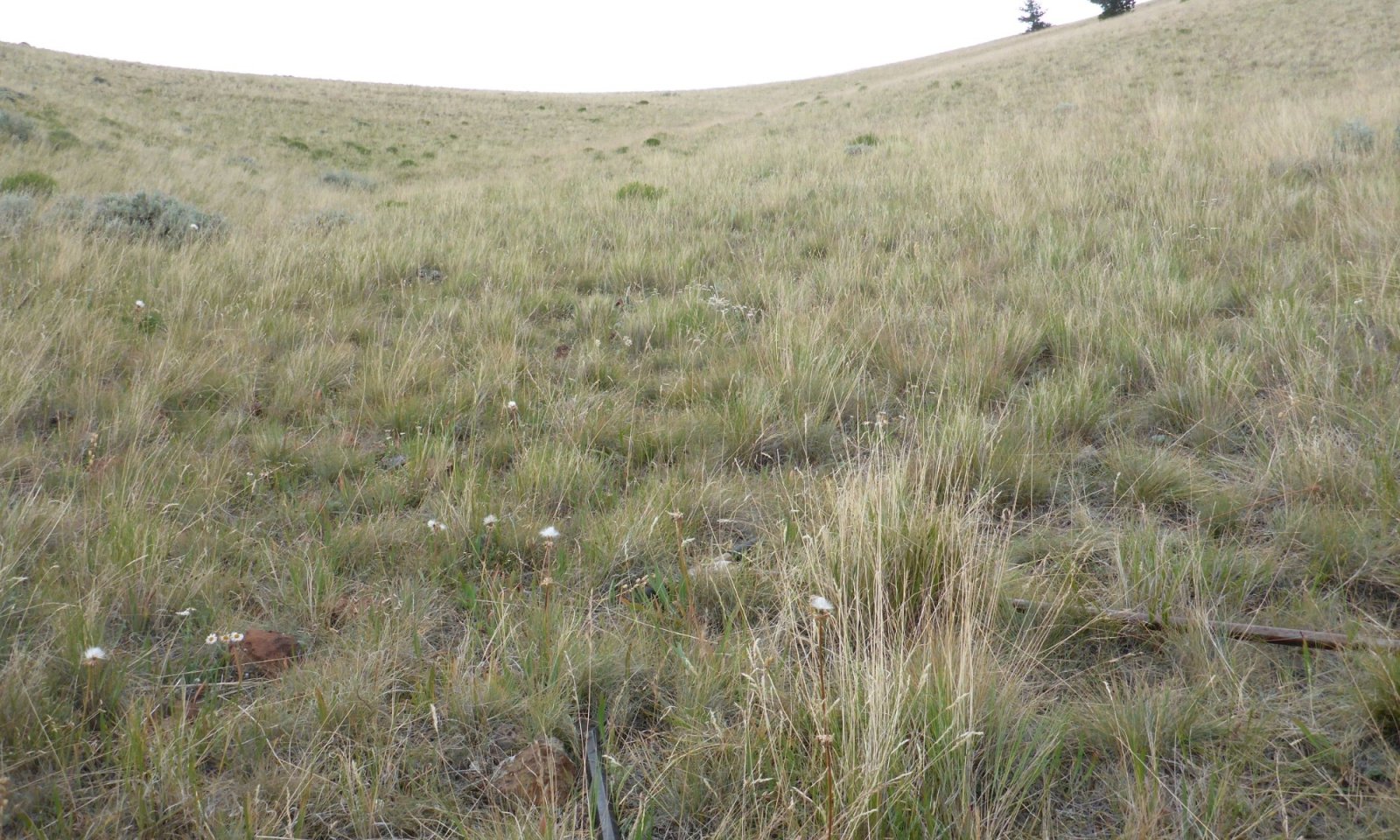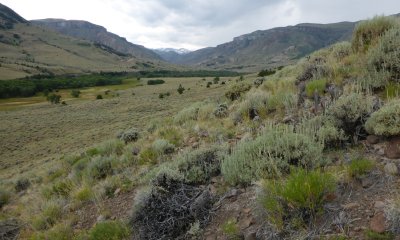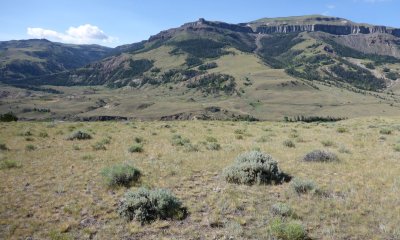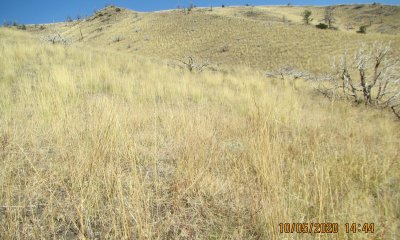
Shallow Igneous (SwIg) Absaroka Lower Foothills
Scenario model
Current ecosystem state
Select a state
Management practices/drivers
Select a transition or restoration pathway
-
Transition T 1-2
Severe and frequent grazing and lack of browse or brush control will transition this State to the Mixed Shrub/Bare Ground State.
More details -
Transition T 1-3
Frequent and severe grazing (yearlong grazing) or compaction from surface traffic, will weaken the mid-stature grasses and allow threadleaf sedge to increase.
More details -
Restoration pathway R 2-1
Brush management, prescribed grazing, and potential range seeding will aid in the restoration to Reference.
More details -
Transition T 2-3
Brush management, or an intense wildfire followed by frequent and severe grazing, will convert the plant community to the Sod-former State..
More details -
Transition T 2-4
Disturbance to the soil surface provides the opportunity for invasive species to find their niche in a community.
More details -
Transition T 3-4
Drought with or without hoof impact or mechanical soil impact to displace the sod opens the niche for invasive species to establish.
More details -
Restoration pathway R 4-5
Integrated weed management, seeding and grazing management will establish a community similar to Reference.
More details -
Transition T 5-4
Any disturbance to or failure in reclaiming the community leaves this State at risk to invasion.
More details -
No transition or restoration pathway between the selected states has been described
Target ecosystem state
Select a state
State 1
Bluebunch Wheatgrass/Mixed Shrub



Description
The Reference State, State 1, is the Bluebunch Wheatgrass/Mixed Shrub State, in response to the dominance of bluebunch wheatgrass and other mid-stature cool-season bunchgrasses that are prominent in each community. Rhizomatous wheatgrasses and short-stature cool-season bunchgrasses are secondary in these communities. Sagebrush and rabbitbrush is present on the site, but is not the major cover class.
Characteristics and indicators
Bunchgrass/Sagebrush State (State 1 - Reference) is characterized by the key species including fifteen percent or less composition by cover of Wyoming big sagebrush, black sagebrush, and fringed sagewort; with 30 percent cover of bluebunch wheatgrass, rhizomatous wheatgrasses (Western and Thickspike), Indian ricegrass, and needle and thread. Minor component to the overall composition is made up of bottlebrush squirreltail, Sandberg bluegrass, mutton bluegrass, prairie junegrass, and threadleaf sedge.
Resilience management
This state occurs in areas that are grazed moderately with periods of rest by large ungulates include livestock (cattle and/or sheep) as well as antelope, deer, and elk. Prescribed grazing and drought planning allows this State to persist. The community is adaptable to drought with management.
Submodel
Description
Shrubs or woody vegetation creates a niche for most herbaceous understory to persist and maintain some vigor in difficult conditions by utilizing the moisture and shelter provided by the canopy as well as protection from grazing. Persistence of drought and/or frequent over use by livestock and wildlife leads to a decline of the herbaceous species, creating the Mixed Shrub/Bare Ground state. This State can be exacerbated by insects and other human disturbances.
Characteristics and indicators
There is a high level of variability of species in this State, that will shift in response to precipitation and to past management. Only one defined community will be provided, with discussion of transitions or variances from this community. The total woody canopy cover does not necessarily always increase with this community, but the percent composition by cover and production is swayed by the decrease of herbaceous vegetation and the relative stability of production by the woody species, creating the appearance of increased canopy by sagebrush.
Resilience management
Risk of wildfire within this state is minimal due to the lack of fine fuels within the understory, but the canopy of the woody vegetation can easily carry a fire under certain climatic conditions. Depending on the prescription of use, trailing and other erosional patterns are highly visible in this State.
Protection from wildfire and use, on a long-term perspective can aid in the transition of the Reference Communities (1.1 or 1.2) to this State as shrubs reach maturity reducing the ability for the herbaceous component to maintain vigor; leading to a high rate of bare ground and shrub cover. As the herbaceous cover declines and the site continues to weaken, the woody cover is susceptible to attack by insects, disease, and general old age that can remove it from the system creating a system that is at risk of invasion or transition to a more degraded State.
Submodel
Description
The Sod-former State is a low-stature community that has shifted from the cool-season bunchgrasses to tillering grass-likes (threadleaf sedge). Fringed sagewort and pricklypear cactus are common.
Characteristics and indicators
The prominent cover is threadleaf sedge. Scattered sagebrush may persist with rubber rabbitbrush and skunkbush sumac. Season of use and species of grazing ungulate will be a factor affecting this cover. The shift in hydrology of this State leads to low vigor shrubs. Most other mid-stature cool-season bunchgrasses are limited to within the canopy of the sagebrush or within the protective cactus clumps.
Resilience management
The dense root map of threadleaf sedge makes this State extremely resistant to change, and resilient to disturbance. Although the establishment of threadleaf sedge is a slow process, it will become a near monoculture stand.
Removal of grazing or disturbance does not provide a shift in the herbaceous cover within this community. The overall health and vigor of both the herbaceous as well as woody cover will improve with the removal of the grazing pressure or disturbance from the community.
Submodel
Description
The transition into the Invaded State, is typically a result of wildfire, a failed controlled burn or other event that removes the sagebrush from the site and allows a readily available seed bank or seed source of the undesirable species to flourish.
Characteristics and indicators
The most common invasive community that is found in the foothills and through the Big Horn Basin and much of the surrounding regions is Cheatgrass. However, there are other threats present, such as thistles, that can develop into near monoculture stands. The loss of diversity, changes to the potential of a site due to allelopathy or other deterrent characteristics of invasive species, and risks or land use capabilities associated with the various invasive species creates a hostile environment for both native species and grazers.
Resilience management
The resilience and resistance of the invaders create a management road block that is usually financially driven. Many times, once an invasion reaches this point, many land managers have no choice but to learn to utilize what they have rather than to try to treat or improve the site, specifically in relation to cheatgrass control.
Submodel
Description
Disturbance to these highly erodible soils (whether it was mechanical, cultural, or natural) reduced the resilience or resistance to support native vegetation or the ability to respond to management in the same manner as an undisturbed site. Changes to soil structure and hydrologic processes reduce the stability and ability to recover. Reclamation or restoration of an area is limited or restrictive due to slope, access, and lack of depth to bedrock. These "altered" lands may, after significant inputs and time, resemble the Reference Communities (1.1 or 1.2), but they will not respond or function the same as the Reference State.
One catastrophic event or several smaller disturbances can lead to the transition to the Altered State from any identified state within the State-and-Transition Model. The soils have not been altered to the extent that they are outside the site characteristics, but the potential has shifted enough that it will not respond like the Reference State.
The time required to allow the redevelopment of structure and the cryptogrammic crust is beyond the natural function of management. The initial flush of vegetation is annual forbs, including mustards, a successional plant community. The site begins its own recovery, but the time required to return to the original conditions (pre-disturbance) can be extensive. The site, however, may become similar in composition to the Reference State.
Characteristics and indicators
The Altered State is characterized by a landscape that has had significant soil disturbance. Early successional plant communities, evidence of mining, or the presence of introduced species (crested wheatgrasses, Russian wildrye, etc.) are indicators of this State.
Resilience management
Stabilization and preservation of as much soil as possible is the mechanism to provide resiliency to this State. The use of mulch or other slope stabilization materials will help in reducing erosional impact and allowing vegetation to establish.
Submodel
Mechanism
Frequent and severe grazing plus no fire (lack of browsing on shrubs) will convert the plant community to the Mixed Shrub/Bare Ground Plant Community. The probability of this occurring is high, especially evident on areas with historically higher precipitation and where drought or heavy browsing does not adversely impact the sagebrush stand.
Constraints to recovery
The lack of a seed bank and the shallow depth to bedrock limits seedling establishment and survival. The unpredictable and variable spring precipitation also limits success of recovery.
Mechanism
Frequent and severe grazing (yearlong grazing) plus wildfire or brush control, will convert the plant community to the Sod-former State. The probability of this occurring is high, especially if the sagebrush stand has been severely affected by drought or heavy use or has been removed altogether.
Constraints to recovery
The dense root mat formed by threadleaf sedge alters the hydrology, effectively removing
moisture from the site, limiting the available resources for other native species. The dense sod also limits the available soil space for seedling establishment. Interpspaces between sod patches are prone to erosion and runoff (limited infiltration of moisture).
Mechanism
Brush management, followed by prescribed grazing, will return this plant community at or near the Reference State. Reseeding after brush management with native species may be necessary to ensure a more rapid transition. If prescribed fire is used as a means to reduce or remove the shrubs, sufficient fine fuels will need to be present. This may require deferment from grazing prior to treatment.
Post management is critical to ensure success. This can range from two or more years of rest to partial growing season deferment, depending on the condition of the understory at the time of treatment and the growing conditions following treatment. In the case of an intense wildfire that occurs when desirable plants are not completely dormant, the length of time required to reach the Reference maybe increased and seeding of natives is recommended.
Mechanism
Brush management, or an intense wildfire followed by frequent and severe grazing, will convert the plant community to the Sod-former State.
Constraints to recovery
The dense root mat formed by threadleaf sedge alters the hydrology, effectively removing
moisture from the site, limiting the available resources for other native species. The dense sod also limits the available soil space for seedling establishment. Interpspaces between sod patches are prone to erosion and runoff (limited infiltration of moisture). The lack of sagebrush or other shrubs and the loss of snow catch to the system also impacts the recovery. Sagebrush is slow to re establish and with altered hydrology may not recover in this system.
Mechanism
Catastrophic or intense wildfires, prolonged drought with severe use by large herbivores or large scale land disturbance creates an environment ready for Invasion. In areas where invasive species are present, the exposed soil and lack of native vegetation from already stressed communities encourages invasive species to establish as a mono-culture with possibly only small isolated remnants of native species.
The canopy of Wyoming big sagebrush is the stabilizer for this community. Once it is removed from a community, it is extremely difficult to re-establish. Wyoming big sagebrush may require 25 years or greater to establish naturally, and in many cases will require outside assistance.
The open raw landscape with minimal native species provides the perfect opportunity for invasive species, primarily Cheatgrass, to establish and take over a community. Drought or insects and disease serve to exacerbate the situation.
Constraints to recovery
The lack of other key herbaceous species also is a constraint on this site. The inability, at this time, to eradicate cheatgrass does not allow for a complete recovery of an invaded community.
Mechanism
Drought, or drought with grazing intensity together, weakens a water limited system allowing invasive species the opportunity to take advantage of the limited moisture. Threadleaf sedge has been seen to die back or die out with prolonged drought opening the canopy and the community’s vulnerability to invasive species. Disturbance by mechanical means or human activities that break the root masses or disturb the soil surface open this closed community to potential invasive species, especially when there is a readily available seed source for those invasive species.
Constraints to recovery
The sod of threadleaf sedge will continue to impact the hydrology and competition for limited resources in this community limiting the potential for recovery. The lack of other key herbaceous species also is a constraint on this site. The inability, at this time, to eradicate cheatgrass does not allow for a complete recovery of an invaded community.
Mechanism
Integrated Pest Management, with Seeding the site to a native mixture - Success is not known to have occurred, and is rated to be low and highly variable for the rate of control of most species. Cheatgrass is one of the most invasive species for many of these sites, although there are other challenges. With intensive weed control and inputs this community can resemble an at-risk community within the reference state, but it is not possible to reach the reference community condition once annuals have established on a site.
Mechanism
Any disturbance that occurs or stress that is placed on the herbaceous cover, weakens the canopy and allows for invasive species to establish if a seed source is present. This State is at high risk of transitioning to an Invaded State. The challenge of successful seedings on a very shallow soils and steep slopes leaves the community vulnerable to invasion.
The challenge of eradicating or reducing invasive species such as cheatgrass prevents recovery of most invaded communities without significant inputs for weed control, seeding with long-term grazing management.
Constraints to recovery
The challenge of eradicating or reducing invasive species such as cheatgrass prevents recovery of most invaded communities without significant inputs for weed control, seeding with long-term grazing management.
Model keys
Briefcase
Add ecological sites and Major Land Resource Areas to your briefcase by clicking on the briefcase (![]() ) icon wherever it occurs. Drag and drop items to reorder. Cookies are used to store briefcase items between browsing sessions. Because of this, the number of items that can be added to your briefcase is limited, and briefcase items added on one device and browser cannot be accessed from another device or browser. Users who do not wish to place cookies on their devices should not use the briefcase tool. Briefcase cookies serve no other purpose than described here and are deleted whenever browsing history is cleared.
) icon wherever it occurs. Drag and drop items to reorder. Cookies are used to store briefcase items between browsing sessions. Because of this, the number of items that can be added to your briefcase is limited, and briefcase items added on one device and browser cannot be accessed from another device or browser. Users who do not wish to place cookies on their devices should not use the briefcase tool. Briefcase cookies serve no other purpose than described here and are deleted whenever browsing history is cleared.
Ecological sites
Major Land Resource Areas
The Ecosystem Dynamics Interpretive Tool is an information system framework developed by the USDA-ARS Jornada Experimental Range, USDA Natural Resources Conservation Service, and New Mexico State University.






